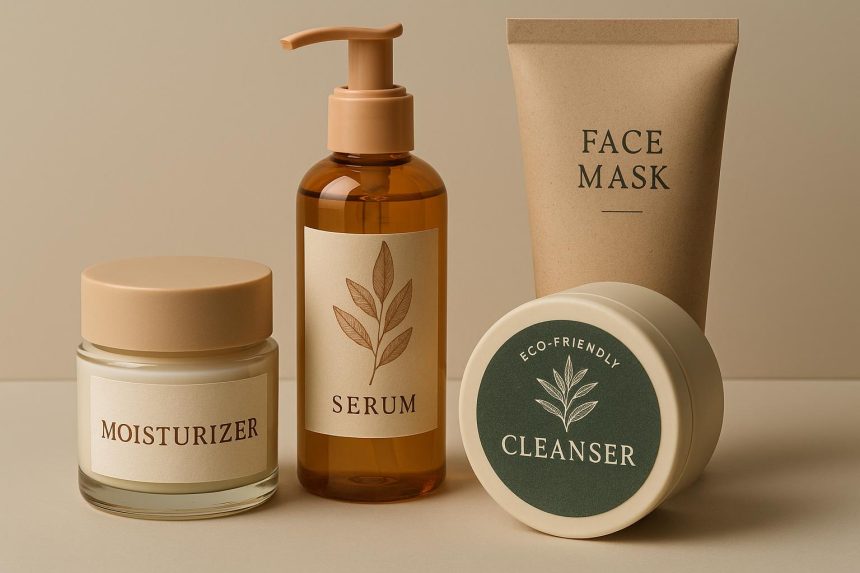Table of Contents
- Introduction
- Sustainable Packaging: A Green Revolution
- Minimalist Design: Less Is More
- Interactive Labels: Engaging the Digital Consumer
- Personalized Packaging: Tailoring the Experience
- Vintage Aesthetics: Nostalgic Appeal
- Bold Typography: Making a Statement
- Artistic Illustrations: Visual Storytelling
- Conclusion
In the competitive beauty market, cosmetic labels serve as crucial extensions of a brand’s identity, conveying its voice, values, and reputation. They create lasting impressions in seconds and differentiate brands on crowded shelves by reflecting qualities like luxury and sustainability. Recent trends include innovative packaging solutions, such as textured finishes and eco-friendly printing, which enhance both the visual appeal and consumer experience. For example, custom labeling for specific product categories, such as lip gloss custom labels, enables targeted storytelling and enhances shelf appeal, helping brands establish unique identities while capturing the attention of increasingly discerning shoppers.
The increasing demand for premium packaging design in the beauty industry is driven by consumers’ desires for aesthetics, authenticity, transparency, and a sense of connection. Beauty brands are focusing on integrating their branding into labels that clearly communicate values such as ingredient transparency, ethical practices, and sustainability. This approach not only differentiates brands but also fosters stronger relationships with consumers who appreciate minimalist design and personalization, ultimately leading to increased brand loyalty and customer satisfaction.
Sustainable Packaging: A Green Revolution
Sustainability remains a key driver shaping cosmetic label trends in 2024 and beyond. Modern consumers increasingly expect their favorite beauty brands to reduce their environmental impact, making packaging choices a vital part of corporate responsibility. Companies are responding by choosing recycled paper, biodegradable plastics, soy-based inks, and innovative materials like plant-based cellulose or compostable bioplastics. This shift has gained momentum due to rising consumer demand and increasing global awareness of the environmental costs associated with plastic pollution and landfill waste.
Major beauty brands are not only cutting waste but also openly sharing their eco-initiatives, often highlighting icons, certifications, or short stories about their green practices directly on the label. Packaging has become a marketing focal point, as eco-friendly options attract environmentally conscious customers and set higher industry standards. Making sustainability a core part of label design positions brands as leaders in environmental care, building trust and loyalty among responsible consumers. The result is a collaborative effort between consumers and brands, united in their pursuit of greener choices.
Minimalist Design: Less Is More
A less-is-more philosophy continues to shape the cosmetic industry, with minimalist design remaining a key trend. Minimalist labels—characterized by clean lines, muted color schemes, ample white space, and simple fonts—convey sophistication and clarity in a world often overwhelmed by visual clutter. This trend shows a modern appreciation for purposeful simplicity, aiming to create a clean visual experience. Brands using minimalist designs often feature only essential details, such as the product name, main ingredients, and sustainability information, helping consumers quickly identify what matters most. Minimalist packaging not only builds consumer trust but also appeals especially to Gen Z and millennial shoppers, who prioritize transparency, straightforwardness, and sustainability. These younger consumers prefer packaging that feels honest and approachable, without unnecessary decoration—a reflection of their desire for less waste and more meaningful experiences.
Interactive Labels: Engaging the Digital Consumer
The digital transformation in packaging is merging the physical and virtual experiences for beauty shoppers. Today’s cosmetic labels are becoming more interactive, acting as dynamic links between brands and their tech-savvy customers. Increasingly, brands are adding QR codes, NFC tech, or augmented reality (AR) triggers to their labels, turning a simple smartphone scan into a rich, multi-layered shopping experience. Consumers can now view video tutorials, ingredient highlights, safety certifications, or even get personalized skincare advice, all from the back or side of the packaging. The use of digital tools helps brands foster long-term engagement by offering exclusive content, limited-time deals, or rewards programs. Some labels also allow customers to trace the sustainability journey of the product or learn about the company’s philanthropic efforts, thereby deepening their sense of connection and control. For brands, interactive labels do more than inform—they create memorable brand interactions that boost loyalty and encourage repeat business.
Personalized Packaging: Tailoring the Experience
The growing desire for individuality fuels the widespread popularity of personalized cosmetic labels. Brands that offer customization allow consumers to imprint their own names, messages, or designs onto product packaging, turning a mass-market item into something uniquely theirs. This level of involvement creates a strong emotional connection, giving shoppers a sense of exclusivity and ownership. Personalized packaging is especially effective for special occasions—such as birthdays, holidays, or bridal showers—making everyday beauty products thoughtful and memorable gifts. Collection launches or limited editions also benefit from custom labels, which help them stand out and justify higher prices. Additionally, when consumers feel recognized and valued by a brand, they are more likely to share their experience on social media, amplifying the brand’s reach and reputation through word of mouth. Ultimately, personalized packaging enhances brand loyalty by celebrating each customer’s individuality.
Vintage Aesthetics: Nostalgic Appeal
Nostalgia’s lasting appeal is clear in the popularity of vintage-inspired label designs. Retro labels, with classic typography reminiscent of apothecaries, warm and muted color schemes, and ornate frame designs, add a sense of history, authenticity, and artisanal craftsmanship to beauty products. By drawing creative inspiration from past eras—such as the Roaring Twenties, mid-century modernism, or even the 1970s glam—brands can tap into a desire for comfort, trust, and timelessness among shoppers. These vintage styles are more than just appearances—they often tell a story, inviting consumers to imagine the product’s legacy and tradition. This tactic is especially appealing to those who value handmade quality and a slower, more deliberate approach to self-care. Retro-inspired labels can be a powerful tool for making products stand out in a busy market, as they attract attention from modern designs while also resonating emotionally with a broad range of consumers.
Bold Typography: Making a Statement
Eye-catching fonts command attention in today’s crowded beauty aisles, where standing out at a glance is crucial for success. The trend toward bold typography—using oversized, custom-designed, or dramatically styled type—shows no signs of slowing down. These choices do more than create visual drama; they convey confidence, brand personality, and a modern aesthetic. Typography-focused labels allow brands to highlight key features or claims, such as “Clean,” “Vegan,” or “SPF 50.” Large, clear fonts provide a practical cue alongside their aesthetic appeal, helping busy shoppers quickly notice and remember important brand or product details. This blend of style and substance makes products both visually striking and easy to navigate, enhancing the overall shopping experience.
Artistic Illustrations: Visual Storytelling
Custom artwork and hand-drawn illustrations are gaining traction rapidly as more beauty brands seek to differentiate themselves through creative visual identities. These labels offer more than just a pretty surface—they are invitations into the world and ethos of the brand. Artistic labels might feature botanicals that hint at active ingredients, whimsical sketches that tell a product’s story, or culturally inspired motifs that celebrate heritage or innovation. The presence of unique artwork fosters a sense of intimacy and intrigue—consumers feel as though they’re acquiring a one-of-a-kind treasure instead of a standard, mass-produced item. Artistic illustrations can additionally signal premium quality, craftsmanship, and creativity, appealing to those who wish to stand out or express personality through their beauty choices. For brands, this approach makes both the packaging and its contents memorable and shareable.
Conclusion
Cosmetic labels are an essential component in the arsenal of modern brands, blending compelling creativity with strategic messaging to captivate today’s discerning consumer. From eco-friendly practices and minimalist sensibilities to innovative digital engagement and beloved nostalgic motifs, embracing emergent label trends allows brands to build authenticity, foster loyalty, and make a lasting impression in a rapidly evolving marketplace. Thoughtful packaging communicates not just what the product is, but why it matters—transforming a simple label into a powerful tool for connection and growth.
Lynn Martelli is an editor at Readability. She received her MFA in Creative Writing from Antioch University and has worked as an editor for over 10 years. Lynn has edited a wide variety of books, including fiction, non-fiction, memoirs, and more. In her free time, Lynn enjoys reading, writing, and spending time with her family and friends.















